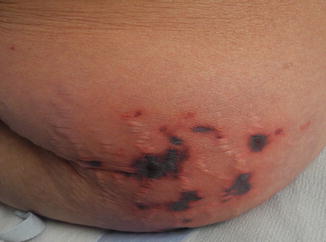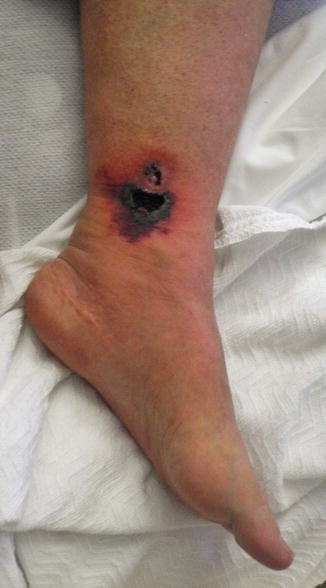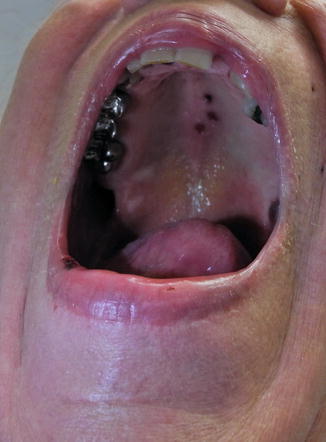Fig. 8.1
Leukocytoclastic vasculitis secondary to anti-thymocyte globulin in the setting of serum sickness
Drugs Associated with Vasculitis
Hydralazine
Minocycline
Isotretinoin
Methimazole
D-penicillamine
Hydralazine
Levamisole
Penicillin
Cephaolosporins
Methotrexate
Cocaine
Propylthiouracil
Interferon
Adalimumab
Etanercept
Infliximab
Sulfasalazine
Phenytoin
Allopurinol
Quinolones
Granulocyte colony stimulating factor
Methamphetamine
Anti-thymocyte globulin
The most frequently cited drugs associated with DIV are those belonging to a subset of drugs associated with anti-neutrophil cytoplasmic autoantibodies (ANCA). ANCA are antibodies to antigens in cytoplasmic granules of neutrophil and monocyte lysosomes with distinct staining patterns. ANCA is usually found in idiopathic vasculitic disorders such as granulomatosis with polyangiitis (GPA), Churg-Strauss syndrome (CSS), and microscopic polyangiitis (MPA). Patients with development of ANCA from drug exposure may present with similar clinical features as patients with idiopathic ANCA-associated disease with associated skin, kidney, and lung involvement. Medications associated with ANCA include propylthioruracil, methimazole, hydralazine, minocycline, sulfasalazine, and monteleukast, as noted in the list below. Minocycline can also cause a severe, ANCA-negative vasculitis that mimics PAN. Propylthiouracil has been associated with ANCA-positive vasculitis more so than methimazole. One study comparing the serological and clinical profiles of patients with ANCA-associated autoimmune disease demonstrated milder disease and lower relapse rates in patients who had ANCA-positive antithyroid medication-induced vasculitis compared to patients with ANCA-positive idiopathic systemic vasculitis.
Drugs Associated with Vasculitis and ANCA
Hydralazine
Propylthiouracil
Methimazole
Minocycline
Monteleukast
Interferon
Tumor necrosis factor-alpha
Sulfasalazine
Cocaine
Levamisole-tainted cocaine
Illegal drugs have also been associated with drug-induced ANCA vasculitis. The illicit or recreational drugs that have most commonly been associated with vasculitis include the sympathomimetic drugs cocaine, methamphetamine, and 3,4-methylenedioxymethamphetamine (“Ecstasy”). More recently, there have been numerous reports of levamisole-tainted cocaine causing vasculitis and vasculopathy. This combination seems to be especially potent in inducing blood vessel disease, which is contributing to the increased incidence of cocaine-related vasculopathy/vasculitis. It is therefore important for clinicians to screen for substance abuse in patients whose presentation is consistent with DIV.
Clinical Presentation
Patients with drug-induced vasculitis may have similar clinical presentations to patients with idiopathic vasculitis. The skin is the most commonly affected organ in drug-induced vasculitis, and can range from involvement of small vessels (arterioles, capillaries, and venules) to more severe disease affecting small- to medium-sized arteries. Typical skin findings suggestive of small-vessel involvement include palpable purpura, petechiae, erythematous morbilliform eruption, urticaria that leaves behind ecchymosis, and small hemorrhagic vesicles (seen in Fig. 8.1). Small- to medium-sized artery involvement presents as livedo reticularis, inflammatory retiform or stellate purpura, subcutaneous nodules, hemorrhagic bullae, ulcers and, in severe cases, digital gangrene (Figs. 8.2, 8.3, and 8.4). While extremely rare, oral mucous membranes including the hard palate and oropharynx can be affected. Such cases have been reported in propylthiouracil (PTU)-induced ANCA-positive disease (Fig. 8.5). Severity of drug-induced vasculitis can range from mild disease, limited to the skin alone, to a more severe and widespread, systemic disease causing multiple organ failure. While the majority of cases of drug-induced vasculitis tend to involve only the skin, they can be accompanied by systemic symptoms such as fever, malaise, weight loss, and arthralgia. Other organs may also be involved, such as the brain, kidneys, lungs, heart, and liver. After cutaneous involvement, the kidney is the most commonly affected internal organ, with affected patients presenting with hematuria and proteinuria and evidence of glomerulonephritis or interstitial nephritis. Involvement of the lung tends to occur in more severe cases and has been associated with intra-alveolar hemorrhage and acute respiratory distress syndrome (ARDS).





Fig. 8.2
PTU-induced vasculitis necrotic presenting as retiform and stellate purpura, nodules and skin necrosis on the trunk

Fig. 8.3
PTU-induced vasculitis presenting as retiform and stellate purpura, nodules and skin necrosis on the upper extremity

Fig. 8.4
PTU-induced vasculitis presenting as a stellate, purpuric ulcerated plaque

Fig. 8.5
Stellate-shaped oral ulcerations secondary to PTU-induced vasculitis
The development of vasculitis typically occurs about 7–10 days after drug exposure, which is believed to correlate with formation of immune complexes and their deposition into blood vessels. Cutaneous lesions in the majority of patients with drug-induced vasculitis usually present on the lower extremities (as shown in Fig. 8.1). Lesions appearing on the trunk, upper extremities, face—including nose and ears—and neck are reported more often with ANCA-positive DIV or idiopathic vasculitides. Furthermore, patients with systemic disease are more likely to complain of painless lesions and paresthesias, or have cutaneous necrosis.
Minocycline-induced ANCA-positive vasculitis has been associated with several cases of biopsy-proven polyarteritis nodosa (PAN). The majority of cases have occurred in teenagers and young adults treated with minocycline for acne vulgaris. Patients may present with fever, weight loss, arthralgia, and myalgia, with livedo reticularis and tender subcutaneous nodules as the most common skin manifestations. Cases of ANCA-negative PAN have also been reported after minocycline ingestion.
Vasculitis has also been associated with the use of the anti-TNF-alpha agents infliximab, etanercept, and adalimumab. In these cases, the skin is the most affected organ (63 % of cases), presenting as palpable purpura, ulcerations, and erythematous macules. The majority of patients found to have leukocytoclastic vasculitis after treatment with anti-TNF-alpha agents have had resolution of their lesions after discontinuation of the drug. However, in patients who were subsequently treated with a different TNF-alpha blocker, there was a higher rate of recurrence of LCV. Golimumab, a TNF-alpha antagonist recently approved for the treatment of rheumatoid arthritis, psoriatic arthritis, and ankylosing spondylitis, has also been associated with luekocytoclastic vasculitis in a recent case report.
As mentioned earlier, levamisole, an antihelminthic drug used in animals, has been linked to cocaine-induced vasculitis. Nearly 70 % of cocaine in the United States is contaminated with levamisole, which serves as a filling agent and is believed to potentiate the effect of cocaine. Levamisole is associated with agranulocytosis and venous thromboembolism, with multiple cutaneous manifestations, including ecchymoses, purpura, hemorrhagic bullae, and in severe cases, necrosis of lips, ears, nose, and cheeks. Patients with levamisole-tainted cocaine vasculopathy often have lesions affecting the lower extremities and the ear, in particular the external pinna (Figs. 8.6, 8.7, and 8.8). Patients are usually ANCA positive and may present with renal and pulmonary involvement, with or without vasculitis. Other positive auto-immune serologies have been reported as well including ANA, antiphospholipid antibodies, and rheumatoid factor. In fact, the presence of multiple positive autoimmune antibodies occurring simultaneously in the same patient is strongly suggestive of levamisole-tainted cocaine vasculitis. Patients may have atypical immunofluorescence (IIF) ANCA patterns as well as discordant IF and enzyme-linked immunosorbent assays (ELISA) combinations, such as P-ANCA with anti-PR-3 IgG, and C-ANCA with anti-MPO IgG. The titers of each study may also be inappropriately out of proportion to each other. Histologically, levamisole-adulterated cocaine may present as a leukocytoclastic vasculitis involving small and medium-sized vessels, a thrombotic vasculopathy, or both.




